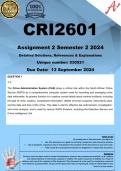CRI2601
Assignment 2 Semester 2 2024
Detailed Solutions, References & Explanations
Unique number: 530521
Due Date: 13 September 2024
QUESTION 1
1.1.
The Crime Administration System (CAS) plays a critical role within the South African Police
Service (SAPS) as a comprehensive computer system used for recording and managing crime
data nationwide. Its primary function is to capture crucial details about criminal incidents, including
the type of crime, location, complainant information, details of known suspects, instruments used,
and the date and time of the crime. This data is vital for effective law enforcement, investigation,
and crime analysis, and is used by various SAPS divisions, including the Detective Service and
Crime Intelligence Unit.
Terms of use
By making use of this document you agree to:
• Use this document as a guide for learning, comparison and reference purpose,
• Not to duplicate, reproduce and/or misrepresent the contents of this document as your own work,
• Fully accept the consequences should you plagiarise or misuse this document.
Disclaimer
Extreme care has been used to create this document, however the contents are provided “as is” without
any representations or warranties, express or implied. The author assumes no liability as a result of
reliance and use of the contents of this document. This document is to be used for comparison, research
and reference purposes ONLY. No part of this document may be reproduced, resold or transmitted in any
form or by any means.
, +27 67 171 1739
QUESTION 1
1.1.
The Crime Administration System (CAS) plays a critical role within the South African
Police Service (SAPS) as a comprehensive computer system used for recording and
managing crime data nationwide. Its primary function is to capture crucial details about
criminal incidents, including the type of crime, location, complainant information,
details of known suspects, instruments used, and the date and time of the crime. This
data is vital for effective law enforcement, investigation, and crime analysis, and is
used by various SAPS divisions, including the Detective Service and Crime
Intelligence Unit.
CAS is primarily located at the Client Service Centre (CSC), which acts as the first
point of contact when a crime is reported. For example, if a robbery is reported at a
local police station, the CSC personnel would enter the details of the robbery into the
CAS. This includes the name of the complainant, the suspect (if identified), the weapon
used, and the specifics of the incident, such as the date and time. These details are
then automatically linked to other police divisions, such as the Detective Service,
which ensures that investigators have real-time access to the case file for follow-up.
This streamlines the investigative process by minimizing the need for manual
communication between divisions.
In addition to aiding individual investigations, CAS also supports crime trend
analysis. The system is used by the Crime Information Analysis Centre (CIAC) to
monitor fluctuations in crime levels across different regions. For example, if a particular
neighborhood experiences an increase in house burglaries, CAS can aggregate the
data, alerting police officers and enabling the SAPS to allocate resources more
effectively. This helps in planning targeted operations, such as increased patrols or
setting up roadblocks in crime hotspots.
CAS also provides benefits in case management. For example, it assists investigating
officers in tracking the progress of cases by storing all relevant documents,
statements, and evidence in one central location. Senior officers can supervise cases
more effectively by monitoring their progress within the system. This leads to improved
accountability and oversight, as officers can quickly check the status of ongoing
investigations or view outstanding tasks. Additionally, reports generated by CAS can
Disclaimer
Extreme care has been used to create this document, however the contents are provided “as is” without
any representations or warranties, express or implied. The author assumes no liability as a result of
reliance and use of the contents of this document. This document is to be used for comparison, research
and reference purposes ONLY. No part of this document may be reproduced, resold or transmitted in any
form or by any means.




